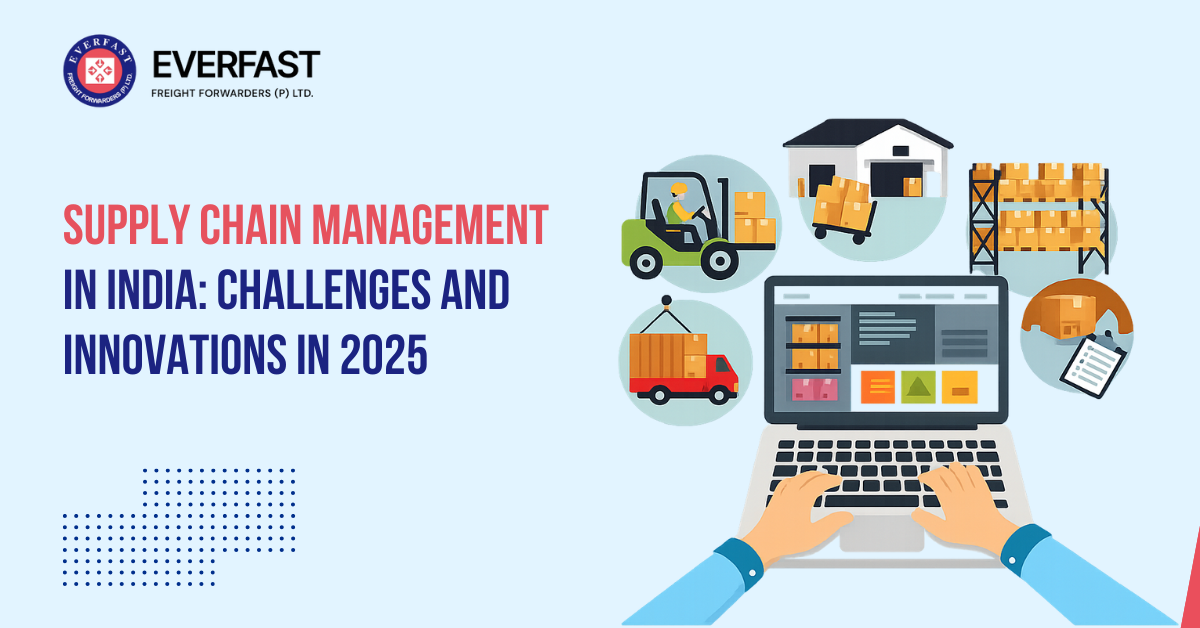
Supply Chain Management in India: Challenges and Innovations in 2025
India’s supply chain sector is undergoing a fundamental shift in 2025. With the country emerging as a global manufacturing and consumption hub, the need for efficient, agile, and sustainable supply chains has never been greater. While persistent challenges continue to hinder progress, innovation and policy support are unlocking new opportunities for transformation.
Challenges Facing Supply Chain Management in India
1. Infrastructure Gaps
Despite significant investments in logistics infrastructure, India still faces critical shortcomings. Poor road quality, limited rail connectivity, and congested ports delay movement and inflate logistics costs. Rural areas, in particular, struggle with inadequate last-mile connectivity.
2. Fragmentation and Informality
A large share of logistics services is still managed by small, unorganized players. This leads to inconsistent service quality, limited scalability, and lack of visibility across the supply chain. Fragmentation also complicates efforts to integrate digital technologies.
3. Regulatory and Compliance Issues
While the Goods and Services Tax (GST) streamlined interstate logistics, other regulatory challenges persist. Businesses face delays due to customs inefficiencies, complex documentation, and differing state-level rules, impacting delivery timelines and compliance efforts.
4. Talent and Skill Shortages
The evolving supply chain landscape demands professionals skilled in data analytics, automation, and digital tools. However, the sector continues to face a shortage of trained manpower, limiting the adoption and effective implementation of modern solutions.
5. Sustainability Pressures
Environmental concerns are growing, and businesses are being urged to reduce their carbon footprint. However, the adoption of green logistics practices, such as electric vehicles and renewable energy, remains slow due to high costs and lack of infrastructure.
Innovation Driving Transformation in 2025
1. Artificial Intelligence and Predictive Analytics
AI-powered tools are now helping businesses improve demand forecasting, optimize delivery routes, and manage inventory more effectively. Predictive analytics enables companies to anticipate disruptions and take proactive measures, enhancing resilience and responsiveness.
2. Blockchain for Transparency and Trust
Blockchain technology is gaining traction in sectors where traceability is critical, such as pharmaceuticals and food. It provides tamper-proof records, enhances accountability, and ensures compliance with global quality standards.
3. Smart Warehousing Solutions
IoT-enabled warehouses, robotics, and automation are transforming storage and order fulfillment operations. Urban centers are increasingly adopting “dark warehouses”—automated hubs designed for high-speed e-commerce delivery.
4. Electric and Autonomous Vehicles
Electric vehicles are increasingly used in last-mile delivery, helping reduce emissions and fuel costs. Meanwhile, trials with autonomous drones and delivery bots are laying the groundwork for the next wave of logistics innovation.
5. Digital Freight Platforms
Online freight marketplaces are connecting shippers with transporters, making the freight procurement process more transparent and efficient. Real-time tracking, digital payments, and load optimization are streamlining logistics operations.
6. Government Support and Reforms
Initiatives like the National Logistics Policy and PM Gati Shakti are driving the development of multimodal infrastructure and integrated digital platforms. These efforts aim to reduce logistics costs to under 8% of GDP and improve global competitiveness.
Conclusion
India’s supply chain sector in 2025 is a story of duality—facing significant challenges, yet brimming with innovation. To build future-ready supply chains, businesses must invest in technology, sustainability, and talent. With continued public-private collaboration, India is well-positioned to become a global leader in supply chain excellence.
